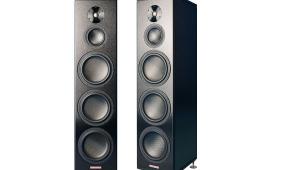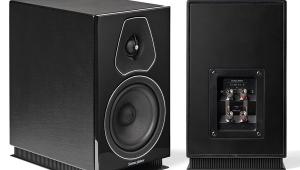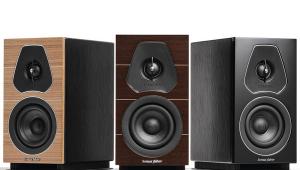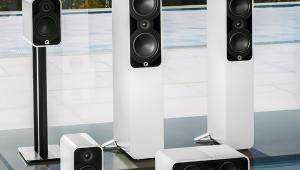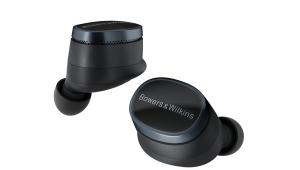Elipson Planet LW and Audio Bridge - £1,399

It is easy to take one look at a product and jump to conclusions about what it was designed to do and the intentions and thinking behind it. One look at the science-fiction prop styling and lustrously shiny finish of the Elipson Planet and you would be forgiven for writing it off as some sort of fancy lifestyle bauble. Two spheres, the size and shape of a steampunk astronaut helmet can only have resulted from a serious need for attention surely?
The reality is that, the Elipson Planet is to French broadcasting what the Rogers LS3/5 is in the UK. The Planet has appeared in various versions over the last 50 years. The most recent version, the Planet L, appeared in 2011 (HFC 350) and quickly revealed itself to be a supremely capable speaker. The spherical cabinet was certainly eye catching, but also allows for the greatest internal volume with the smallest external one while helping to keep resonance at bay.
With the passive Planet L proving very able indeed, it stands to reason that an active version sounds promising too. The Planet LW here was actually launched in 2012 and combines the 6.5in doped paper mid bass driver and the soft dome tweeter used in the Planet L with the IcePower Class D amps that were originally specified in the Music Centre all-in-one system. The most interesting technical decision taken by Elipson was to fit a stereo amp to both speakers. This means that each driver has its own amplifier channel, which is placed behind the crossover and makes the LW a truly self-contained active.
The reason that Hi-Fi Choice held off from reviewing the LW at launch stemmed from the other decision that Elipson took in the design of its speaker. The LW has no physical connection on the chassis. Instead the LWs use a closed wireless network to communicate firstly with one another and then with a transmitter. This took the form of a pair of dongles, one USB and one 30-pin Apple connector. These were both capable of transmitting a lossless signal, but left the Planet LW feeling more like a lifestyle product than a true hi-fi one.
To try and make good on correcting this perception, Elipson has now released the Audio Bridge. This is a small input box that allows for the connection of sources via either an analogue RCA or optical input. A nod to convenience is also present via the fitment of an aptX Bluetooth module as well. The Bridge is paired to two LWs (meaning that existing units can have one added), but if you turn it off, you can still use the supplied dongles too. This gives you a reasonable if not outstanding selection of inputs to choose from. The only catch is that the Bridge doesn’t increase the sampling rate on offer, which remains locked at 16/48 meaning that however hi-res your source material, the Elipson will only ever work up to this rate.
The rest of the news is almost entirely good, however. The Planet LW is every bit as immaculately finished as its passive brother. This means it feels very substantial and the attention to detail is impressive. The paint in particular is exceptional with a depth and shine that considerably more expensive equipment can fail to match. Each speaker is hefty and almost entirely inert further aiding the benefits of the spherical form. Only the small and plastic remote and the slow volume ramp spoil the genuinely high end feel to them. The Audio Bridge is small and relatively light, but the construction is perfectly satisfactory.
The matching accessories are impressive too. Each LW is supplied with a mounting ring to place it on a flat surface but Elipson also offers dedicated floorstands, wallmounts and an amazing-looking ceiling mount as options too. These various fittings mean that a pair of Planet LWs and an Audio Bridge should be easy enough to accommodate although it will require three mains connections to make it work.
Sound quality
You should be prepared to rustle up enough plugs, though. After performing the simple pairing setup and with a Naim ND5 XS connected to the analogue input of the Bridge, the LWs demonstrate real ability. The most interesting part of this is that the LW is subtly different to its passive brethren. This is most apparent in the bass response, which is exceptional for a speaker of this size. There is depth and control that gives the Elipson tremendous punch and drive for a speaker of this size. This is partly down to the bass port, which manages to move a significant amount of air without becoming audible itself. The authority this lends to music that needs a little low-end shove is considerable. Elipson quotes the same frequency response for the passive L as it does the active LW, but in use, the LW reaches its lower numbers with a greater effortlessness than the bald numbers suggest.
The bass might be notable, but it serves to finish an extremely clean and consistent frequency response. The Elipson has seemingly been set up to be comparatively smooth and civilised, but this doesn’t prevent the detail retrieval and tonal accuracy being notably good too. The Planet LW manages to make excellent use of the concentric driver principle in that there is a very wide sweet spot that results from placing them roughly 2m apart with slight toe-in. This never becomes overly diffuse, however, and there is always a very definite sense of the positioning of musicians and instruments as well as a sense of front-to-back depth. Some rivals can sound a little more exciting, but few are as satisfying to listen to long term.
Most of these attributes are available via the dongles, but what is interesting is that some comparative tests with lossless FLAC played via laptop and dongle and then via the Naim into the Audio Bridge do marginally favour the latter. As the Audio Bridge will be carrying out processing on all the inputs, even the analogue one, in order to transmit wirelessly to the speakers, this is a little surprising, but it does seem that the Audio Bridge does this with sufficient transparency to retain some of the character of the source equipment. This means that as well as offering a bit more flexibility in terms of input choice, the Bridge does eke out a little more performance than the dongles can – although, of course, you can still turn the Bridge off and pair with the dongles if you want.
Conclusion
There is a great deal to like about the way that the Planet LWs go about making music and this is given considerable extra flexibility thanks to the Audio Bridge. In a perfect world, there would be a slightly wider choice of inputs and the wireless connection would not preclude using hi-def audio, but the first issue can be alleviated depending on your source equipment while you will have to decide for yourself if you feel that the lack of hi-res will be a problem. For me at least, these issues don’t detract significantly from a beautifully implemented and impressively flexible active speaker.
LIKE: Powerful and refined sound; good looks; beautiful build
DISLIKE: Limited inputs; no hi-res; fiddly remote control
WE SAY: An innovative and entertaining product that is slightly specialised, but capable of great results
DETAILS
PRODUCT Elipson Planet LW and Audio Bridge
ORIGIN France/China
TYPE Two-way wireless loudspeaker system
WEIGHT Speaker: 7.5kg; Audiobridge: 0.4kg
DIMENSIONS Speaker: 290mm diameter; Audiobridge: (WxHxD) 160 x 36 x 160mm
FEATURES
• Coaxial driver arrangement – 165mm mid with 25mm tweeter
• Built-in Class D amplifier
• Quoted power output: 100W
• aptX Bluetooth receiver
DISTRIBUTOR BBG Distribution Ltd
TELEPHONE 01923 205600
WEBSITE elipson.com/en
 |
Inside this month's issue:
Q Acoustics 3020c standmount loudspeakers, Perlisten R10s active subwoofer, Quad 33 and 303 pre/power amps, Acoustic Solid Vintage Full Exclusive turntable, newcomer Fell Audio Fell Amp and Fell Disc and lots, lots more...
|









